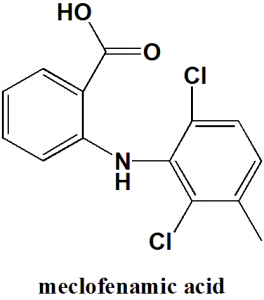MECLOFENAMIC ACID Synthesis, SAR, MCQ, Structure, Chemical Properties and Therapeutic Uses
Meclofenamic acid
IUPAC nomenclature
2-[(2,6-dichloro-3-methylphenyl)amino]benzoic acid
Classification
- NSAID
- Anthranylic acid derivatives
Physiochemical Properties
| S. NO. | PHYSICAL AND CHEMICAL PROPERTIES | |
| 1 | Molecular weight | 296.1 g/mol |
| 2 | Physical appearance | Solid |
| 3 | Melting point | 257°C |
| 4 | Solubility | 30 mg/L |
| 5 | Octanol/water partition coefficient | 5 |
| 6 | Presence of ring | Phenyl |
| 7 | Number of chiral centers | Not present |
Mechanism of Action
- Meclofenamic acid inhibits the synthesis of prostaglandins and also competes for the binding at the prostaglandin receptor site.
- In-vitro studies shows that meclofenamic acid also inhibits leukocyte 5-lipoxygenase activity
Structure Activity Relationship
General SAR for anthranylic acid derivatives can be summarized as follows:
- Activity decreases when substitution on anthranilic acid ring.
- Activities due to substitution on the N-aryl ring follows the general order m > o > p.
- For disubstitution products, activity was found to be maximum when o and m positions are substituted near to each other on the N-aryl ring.
- Substitutions on the N-aryl ring with such groups which leads the ring to be noncoplanar with the anthranilic acid ring increases the binding of the drug and hence, increases the activity (meclofenamic acid being more active than flufenamic acid).
- NH-moiety of the anthranilic ring is important for the activity of the drug, and replacement of NH- moiety with O, CH3, S, SO2, N-CH3 or N-COCH3 groups decreases the activity of drug.
- Position of the acidic function is important for the activity and not the nature of acidic function. [1]
- Replacement of carboxylic acid function with isosteric tetrazole function has no significant effect on the activity of compound.[1]
Method of synthesis
Reaction of potassium salt of 2-bromobenzoic acid with 2,6-dichloro-3-methylaniline in presence of copper (II) bromide in a mixture of N-ethylmorpholine and diglyme produces meclofenamic acid. [2]
Therapeutic Uses
Meclofenamic acid is used for:
- Short-term treatment for mild to moderate pain
- Dysmenorrhea
Side Effects
Side effects of meclofenamic acid are:
- Skin rash
- Changes in vision
- Shortness of breath
- Weight gain
- Swelling
- Stomach bleeding
- Nausea
- Jaundice
- Pale skin
- Difficulty in urination
- Anemia
- Skin reactions
- Indigestion
- Nausea
- Tremors
- Stomach pain
- Confusion
- Diarrhea
- Constipation
- Drowsiness
- Dizziness
- Headache
MCQs
Q.1 Which statements are correct with respect to the physicochemical properties of drug Meclofenamic acid?
I. Molecular weight:296.1 gm/mol
II. Appearance: Transparent liquid
III. Melting point: 257oC
a) I, II
b) II
c) I, II, III
d) I, III
Q.2 Match the following of the drugs with their correct IUPAC names.
| i. Meclofenamic acid | A. 4-hydroxy-2-methyl-N-(5-methyl-1,2-oxazol-3-yl)-1,1-dioxo-1λ6,2-benzothiazine-3-carboxamide |
| ii. Ibuprofen | B. [2-(2,6-Dichloroanilino)phenyl]acetic acid |
| iii. Isoxicam | C. 2-[(2,6-dichloro-3-methylphenyl)amino]benzoic acid |
| iv. Paracetamol | D. (RS)-2-(4-(2-Methylpropyl)phenyl)propanoic acid
|
a) i-C, ii-D, iii-A, iv-B
b) i-D, ii-B, iii-A, iv-C
c) i-C, ii-A, iii-D, iv-B
d) i-B, ii-C, iii-D, iv-A
Q.3 Mechanism of action of Meclofenamic acid includes?
I. Inhibition of the synthesis of prostaglandins
II. Inhibition of acetylcholinestrases enzymes
III. Drug competes for binding site at prostaglandin receptor
IV. Decrease in level of ACh
a) II, IV
b) I, II, III, IV
c) I, III
d) II, III, IV
Q.4 Correct sequence for True/false for the classification of the drug can be?
- Meclofenamic acid: Carbamates anticholinestrase
- Cyclophosphamide: Nitrogen mustard alkylating agent
- Phentolamine: ß-adrenergic blocker
- Docetaxel: Taxanes
a) TFFT
b) FTFT
c) TTTT
d) TTFF
Q.5 An incorrect statement related with the SAR of Anthranylic acid derivatives is?
a) Activity decreases when substitution on anthranilic acid ring.
b) Activities due to substitution on the N-aryl ring follows the general order m > o > p.
c) For disubstitution products, activity was found to be minimum when o and m positions are substituted near to each other on the N-aryl ring.
d) Substitutions on the N-aryl ring with such groups which leads the ring to be noncoplanar with the anthranilic acid ring increases the binding of the drug and hence, increases the activity
Q.6 Which drug is synthesized on reaction of 2-bromobenzoic acid with 2,6-dichloro-3-methylaniline in presence of copper(II) bromide?
a) Flufenamic acid
b) Meclofenamic acid
c) Tolazoline
d) Physostigmine
Q.7 Side effect of drug Meclofenamic acid?
a) Difficulty in urination
b) Jaundice
c) Weight gain
d) All of the above
Participate in Online FREE GPAT TEST: CLICK HERE
Participate in Online FREE Pharmacist TEST: CLICK HERE
Participate in Online FREE Drug Inspector TEST: CLICK HERE
ANSWERS
1-d
2-a
3-c
4-b
5-c
6-b
7-d

